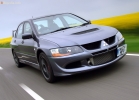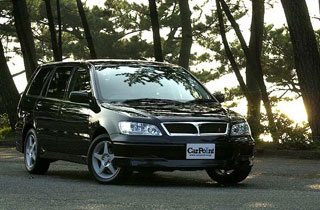Test drive Mitsubishi Lancer Evolution VIII 2003 - 2005 sedan
Cut and mandrel
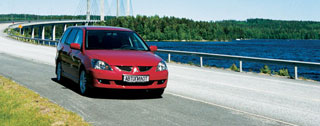 The brilliance of diamonds is explained simply - refraction of ordinary light. The new Mitsubishi Lancer has the ability to change at different angles of vision.
The brilliance of diamonds is explained simply - refraction of ordinary light. The new Mitsubishi Lancer has the ability to change at different angles of vision. At the presentation of the ninth generation, Mitsubishi Lancer Opinions and the impressions of this car changed literally. Compact, if you look from afar, it turned out to be solid and spacious with a closer acquaintance. Accustomed to the slightly conservative style of the sedan, you are immediately surprised at how literally a few strokes in the Art Nouveau style can be given a completely different species of the station wagon.
Lancer, related to class C, is equal in almost all parameters or surpasses the interclass Carisma that is replaced by it: it fell into the next grinding wave, when cars within the class grow if not in overall dimensions, then in the base. For the consumer, this is quite pleasant - for the same or slightly big money, it becomes possible to get at least a more spacious interior.
One face for two. We can say that the new Lancer has long appeared in Japan. The island Lancer Cedia is formally eighth -generation Lancer, and we have already been presented to us. However, when comparing these machines, exactly the same basic body panels and a very similar interior decoration are noticeable. Okay, let's leave it on the conscience of the Japanese. Moreover, the motors and transmission of the Far Eastern version are really different. Perhaps Mitsubishi just wants to prove that three years sharing this Lancer and TU CEDIA were not in vain. And the new corporate identity, most pronounced in Outlander, must also be reflected in the European model. First of all, it is a characteristic central beak that turns from a hood lining, as well as new headlights. The overall impression of the appearance of the sedan seems to be good, but the hood and trunk seem disproportionately small relative to the large body. At the station wagon, this effect is manifested noticeably less. Its back is made in a fashionable facet of style, and due to the lack of small details, the car looks more proportional.
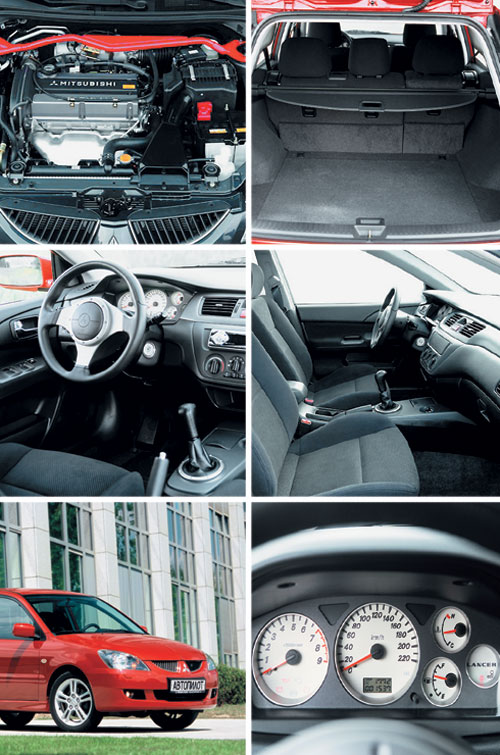
Such a diverse form of form was partly a fundamental task of designers. Because the station wagon and the sedan, according to the plan of marketers, Mitsubushi, are intended for completely different categories of customers. Well, with four -door modifications, everything is clear - thanks to a relatively low cost, and sedans will offer at a price of about $ 14,000 - this is an attractive option for those who choose their first imported car in their lives. We will not forget, by the way, about the presence of ABS, EBD, airbags and electric windows - they are included in the package. Yes, and for an expensive version of 1.6 liters, which is more expensive by $ 1000 not only for an additional 16 hp, but also for a richest equipment with electric mirrors and their heating and seats, such a style is also more plus than a minus. The station wagon with a 1.6 liter engine is more than a sedan by $ 1660, and it is aimed at a more modern, dynamic and wealthy owner - only a two -liter engine is planned to be placed on this body type.
Sport Mode. The first option that happened to meet was a sedan with an automatic machine and a 1.6-liter engine. Again I had to change ratings in the process of dating. It seems like not the poorest equipment, but there is no finish on the inside of the trunk cover. Yes, and plastic in the salon, although high -quality, but modest - typically Japanese approach. Poking the Outlander style panel emphasizes the scope, and inserts under a black tree seem to create an impression of a certain claim for luxury. Automatic transmission is adaptive, InVecs II with manual control mode, which Mitsubishi is called Sport Mode.
The first impression was not very pleasant: it seems that a driver drove up to us, extremely scrupulously related to Finnish speed restrictions or fuel consumption. The transmission was so well adapted to his habits that she did not want to accelerate more than 100 km/h at all. Of course, we tried to trample more - after 80 km/h, the car seems to come to life. Apparently, because the engine more often has to spin at revolutions of more than 3,000. In this range, it is not only heard, but the dynamics seems to be revived. It seems that the point is not about the transmission, but in the engines that are configured for the ecological norms of Euro-4. Well, to protect nature is a good thing.

Don't think about seconds. After the automatic mode, we switch to Sport Mode, and the character of Lancer changes sharply. We are amazed! The fact is that many sequential machines suffer from thoughtfulness - the box spends a lot of time thinking about choosing a driver. The automatic transmission on Lancer is a pleasant surprise: the steps switch so quickly that it seems as if you are going on ordinary mechanics. Is the control unit herself? No, if you try to turn on the program that requires the output revolutions of the engine, nothing will happen. But in the permissible range, the box carefully fulfills the driver's requirements, allowing you to effectively slow down the engine. This mode does not affect the service life of the units very well, but sometimes it can be very useful. For example, on slippery after the recent rain with gravel lane.
The Test drive route just passed through such sites. On them in the 80s-90s, the legendary rally routes of 1000 lakes passed. We are convinced that pleasantly elastic on the asphalt, the suspension does not like small pits and bumps, vengefully broadcasting blows to the driver and innocent passengers. However, you can not go very quickly, and then the suspension provides a good level of comfort.
Sports fashion. From the first generation, Lancer was distinguished by a passion for sports: in the year of his appearance on the market, he won the southern cross. So the route in the vicinity of Juvyskyul was laid precisely in places of military glory. And among the cars participating in the presentation, there were future top models-two-liter station wagons. Future ones because they will be represented in European and Russian markets only at the beginning of next year.
The top of the version here is emphasized not only for this version of the two -liter engine and a sports package. The latter includes a sports suspension with a reduced road clearance, a spacer between front suspension racks, 16-inch tires on cast discs, sports seats and a MOMO steering wheel. Here is the transmission - exclusively mechanical. And the modesty of the sports interior without wooden elements - they were replaced by inserts painted under dark silver - makes a more favorable impression than the decorativeness of the Comfort version.
The dynamics of acceleration with a two -liter engine is much higher than that of a sedan with an automatic machine and a 1.6 liter engine. But the most powerful power unit in the gamut is disclosed only at high speeds - below the 3500 mark, its return is frankly not impressive. But within 3500-6500, it pleases with a quick reaction and excellent traction. The box also left only good memories - a short move of the lever and an excellent accurate inclusion. The sports suspension is tougher than the standard, but despite this (more precisely, due to this), passing small irregularities does not represent such a sharp contrast with even areas.
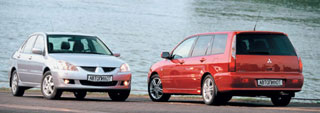 Most pleased the salon and trunk of the station wagon. Thanks to the long base and on the sedan, the rear seat passengers are very spacious - so if the car is used as an official or even taxi, then passengers will not have to complain. On the station wagon, according to Japanese tradition, it is possible to adjust the angle of inclination of the back. More precisely, the back, since the sofa is divided in a proportion of 60:40. True, the transformation of the rear seat is carried out only by lowering them - the pillow is not removed. But when folding the backs, an almost flat cargo platform forms.
Most pleased the salon and trunk of the station wagon. Thanks to the long base and on the sedan, the rear seat passengers are very spacious - so if the car is used as an official or even taxi, then passengers will not have to complain. On the station wagon, according to Japanese tradition, it is possible to adjust the angle of inclination of the back. More precisely, the back, since the sofa is divided in a proportion of 60:40. True, the transformation of the rear seat is carried out only by lowering them - the pillow is not removed. But when folding the backs, an almost flat cargo platform forms. The official premiere of the European Sedan Lancer will take place at the Motor Show in Moscow. Not the first case, but the previous ones can be counted on the fingers of one hand.
Text Valery Chusov, photo of the author and Mitsubishi Motors
Model/Modification Mitsubishi Lancer 1600 Comfort Mitsubishi Lancer 2000 Sport
Manufacturer/country Mitsubishi Motors Corporation/Japan
ENGINE
Type/number/location of gasoline cylinders/4/in -line
Working volume (cubic meter) 1584 1997
Power (kW (L.S.) at about./Min.) 72 (98) at 5000 99 (135) at 5750
Moment (Nm at about./Min.) 150 at 4000 176 at 4500
TRANSMISSION
Front drive
Automatic gearbox 4-speed mechanical 5-speed
Brakes, safety
Front/rear ventilated disk/disk
Assistering electronic systems ABS, EBD
Front and side airbags in front
pouting curtains
Dimensions/mass
Length/width/height (mm) 4480/1695/1445 4485/1695/1450
Wheel base/clearance (mm) 2600/165 2600/135
Tires 195/60 R15 195/50 R16
Mass weight/full (kg) 1205/1750 1320/1780
The volume of the fuel tank (L) 50
Maximum speed (km/h) 176 199
Acceleration to 100 km/h (sec.) 13.6 10.0
Fuel consumption (city/highway, l/100 km) 10.3/6.4 11.7/6.8
The price in Moscow is $ 16,150 $ 20,000 (approximately)
Source: "Autopilot"

